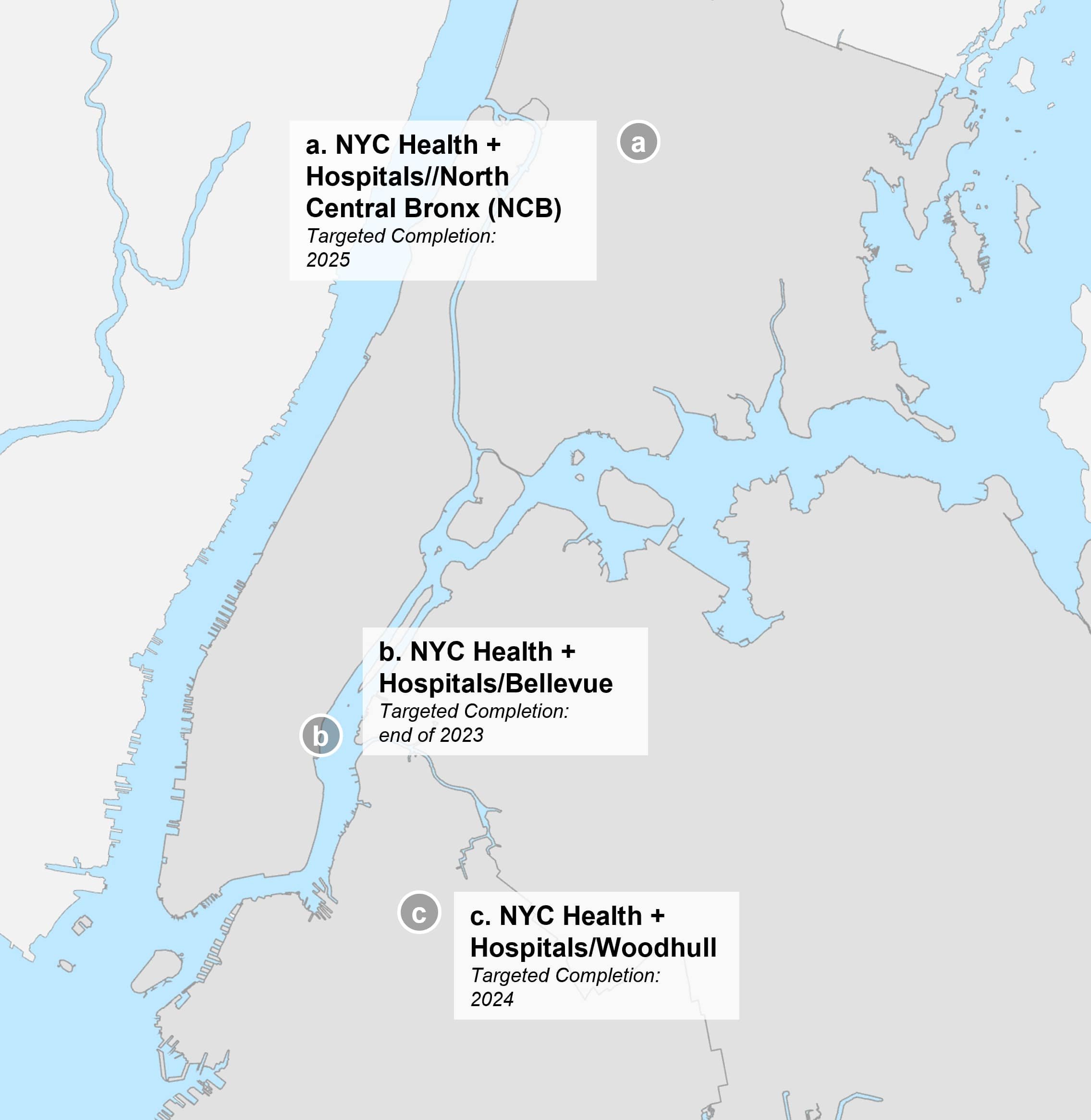Investment Priorities
Investment Priority 2:
Strengthen public health and safety
The City supports the health of New Yorkers by strengthening our health and hospitals system, improving the quality of and access to outdoor public space, investing in heat mitigation and cooling infrastructure, reducing emissions of air pollutants, enhancing efforts to fight crime and gun violence, and continuing to improve our multimodal transportation network.
Strengthening our health and hospitals system
In 2022, the City launched the New York City Pandemic Response Institute (PRI), a new partnership with ICAP at Columbia University and The City University of New York Graduate School of Public Health and Health Policy (CUNY SPH) to help New York City learn from the lessons of the COVID-19 pandemic and tackle the urgent public health emergencies currently facing New Yorkers — from infectious diseases to climate-related events. The PRI is a new part of the public health infrastructure that will strengthen the City’s ability to face public health crises effectively and equitably. Operated using a coalition, hub-and-spoke model that includes additional industry and community partners, the PRI will identify or build physical locations in each borough. It is anticipated each spoke will function as a community arm of PRI to offer programming and community convening. The primary goals of the PRI are to ensure that all New Yorkers have access to health solutions, information for decision-making, and the capacity to prepare and respond to public health emergencies.
The H+H system plays a critical role in both addressing longstanding health inequities and providing urgent services for acute medical issues. H+H makes investments in its hospitals and facilities to improve safety, patient comfort, and operations. Investments include updating aged infrastructure, maintaining a state of good repair, enhancing building life safety systems, as well as installing modern technology equipment to ensure secure and seamless healthcare services.
H+H Outposted Therapeutic Housing Unit
H+H is committed to improving access to health services for incarcerated patients with serious health conditions through the Correctional Health Services’ (CHS) Outposted Therapeutic Housing Unit (OTxHU) initiative. These units will house CHS patients who do not require inpatient admission but would benefit from close, regular access to specialty and subspecialty care available in the hospitals. This unique model of care will increase patients’ access to chemotherapy, radiation therapy, and other kinds of specialized treatment. The units will enable CHS’s most clinically vulnerable patients to reside in more therapeutic and appropriate settings while reducing the current transportation burdens to and from the hospitals. Design and/or construction are underway for the OTxHU sites at H+H/Bellevue, H+H/Woodhull, and H+H/North Central Bronx locations.
OTxHU planned locations & targeted completion dates

- Source: NYC Health + Hospitals
Improving and expanding outdoor public space
Investments in outdoor public spaces improve our health: parks, plazas, sidewalks, and even streets provide essential, safe spaces for recreation, exercise, and socializing. City agencies responded to the increased need for well-ventilated public space during the COVID-19 pandemic by allowing more flexible uses of our existing outdoor infrastructure. SCA invested in outdoor recreational facilities such as playgrounds and athletic fields that serve both students and residents (during non-school hours).
City programs support the transformation of existing assets into multifunctional outdoor spaces, such as the DOT Open Streets program. The program limits vehicular access or closes streets to cars, transforming them into community assets and open spaces for pedestrian and cyclist use. The City is investing in expanding the Open Streets program to increase participation of historically underserved neighborhoods, providing maintenance, technical assistance, and programming to many Open Streets locations. In addition to expanding the Open Streets program, DOT is committing capital funds to make the City’s most successful Open Streets permanent, including 34th Avenue and Woodside Avenue in Queens, Willis Avenue in the Bronx, Underhill Avenue in Brooklyn, Minthorne Street in Staten Island, and Dyckman Street (Quisqueya Plaza) in Manhattan. The City also has other programming efforts to expand and transform how public space can be used, including an expanded Privately Owned Public Spaces (POPS) program.
The City has continued to work on plans for future additions to our public space, such as with the proposed Gowanus Waterfront Access Plan (part of the larger Gowanus rezoning). The Plan will generate four acres of new waterfront open space with esplanade areas elevated to respond to long-term daily tidal flooding. The Plan will also incentivize private developers to incorporate community amenities like comfort stations, boat launches, and historic interpretation elements. The Plan also calls for public investments in new waterfront open space, city-owned street ends, and design interventions around bridge crossings to support the overall vision of a safe, resilient, and active waterfront esplanade. See Guiding Principle 4 call-out box on the Gowanus Neighborhood Plan for more information.
Enhancing public safety
The City is focused on improving public safety facilities to strengthen relations between the community and the police. The NYPD is renovating its 40th and 116th precinct buildings to provide state-of-the-art facilities for officers and welcoming spaces for community members. The 40th precinct will introduce the very first ever community event space inside of a precinct to reflect the collaborative effort between the community and police to create safer streets. Both buildings will also promote environmental sustainability through features that include green roofs to reduce stormwater runoff, high-efficiency fixtures to reduce energy usage, and solar panels.
The DOC is also investing in public safety through the design and construction of a new Corrections Training Academy. The new academy seeks to create a conducive learning environment for Correction Officer recruits and existing staff, with the capacity to serve up to six hundred Correction Officer recruits per class and two hundred “In-Service” personnel requiring training courses. Currently, the DOC uses shared space that was not initially created as a training facility to train their recruits. Even though great learning and preparation take place there, a new state-of- the-art training facility will be another step in the modernization of DOC. With contemporary training techniques in an area large enough and solely dedicated to training staff, the DOC will have more staff efficiently and effectively trained resulting in an enhancement in public safety.
Improving our multimodal transportation network
In the next decade, we will invest in the City’s many interconnected transportation options to help more New Yorkers access essential services, go to work, and move about the City. In December 2022, Mayor Adams and Governor Kathy Hochul released ‘New’ New York: Making New York Work for Everyone, a set of 40 proposals intended to make New York City the best place to work and serve as a roadmap for the City’s future. The plan addresses interconnected challenges affecting all New Yorkers, from transportation to housing and from public space to childcare. It focuses on three goals including reimagining NYC’s commercial districts, making it easier for New Yorkers to get to work, and generating inclusive, future-focused growth. The plan includes a focus on pedestrian access and safety, public space, bicycle infrastructure, and streetscapes in Commercial Business Districts across the City.
As part of the plan, the City promises to embrace a broad range of car and truck-based transportation improvements so people and goods can get to their destinations faster, more reliably, and in a more sustainable way.
The TYCS also includes $5.4 billion for street reconstruction with $3.5 billion allocated for Vision Zero. This will include continued investment in much-needed safety improvements to our streets, bike lanes, and pedestrian walkways through DOT’s Vision Zero initiative, which continues to show progress since launching in 2014. Between 2014 and 2021, pedestrian fatalities nationwide increased by over 50%. During that same period, pedestrian fatalities in New York City declined by 10%. In February 2023, DOT released a new Borough Pedestrian Safety Plan, which targets the next set of streets, intersections, and areas that will be the focus of Vision Zero initiatives.
Additionally, the City’s investment strategies consider dynamic shifts in travel patterns. For instance, despite continued lags in bus and subway ridership, bike and ferry ridership now exceed pre-pandemic levels. DOT continues to enhance the pedestrian, transit, and bicycle network citywide, in addition to planning for multiple other accessibility, safety, and transit improvements as part of the NYC Streets Plan. DOT is creating a connected spine of protected bicycle lanes and greenways complemented by neighborhood networks that will make cycling an even safer and more viable transportation option for more New Yorkers. This is complemented by the Citi Bike program, which is growing to serve a wide range of neighborhoods, often those with fewer transportation options.
Through its Great Streets capital program, DOT has also committed over $525 million to ongoing street safety redesign projects on four dangerous corridors to improve pedestrian safety, access to transit and bicycle facilities as well as streetscape beautification and greenery. These corridors include Atlantic Ave, the Grand Concourse, 4th Ave in Brooklyn, and Queens Boulevard.
The City’s waterways continue to be an important part of our overall transportation strategy. This past summer, the City rolled out the NYC Ferry Forward plan to establish a more equitable, accessible, and financially sustainable citywide ferry system. The ferry system connects neighborhoods to job centers and brings much-needed transit access to NYC’s waterfront and recreational areas. On top of existing investments in the fleet, a homeport facility, and multiple landings throughout the City, EDC is constructing a second homeport in Atlantic Basin for vessel storage, maintenance, and repair. EDC will continue to invest in ferry maintenance and repair and is working towards investments that will improve the environmental impacts of NYC Ferry operations.
We are also working to bring the City’s existing transit network to more New Yorkers by investing in pedestrian mobility and accessibility improvements (see call-out boxes on Pedestrian Mobility and Accessibility and DOT Priority Investment Areas).
